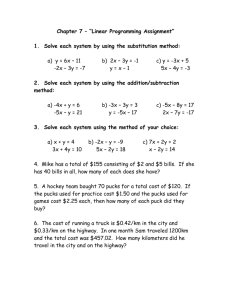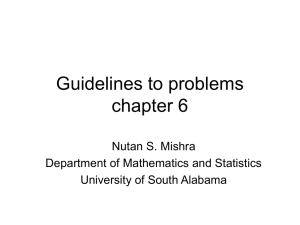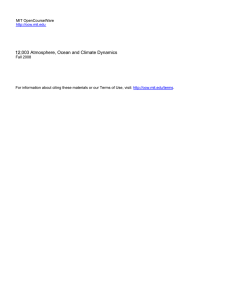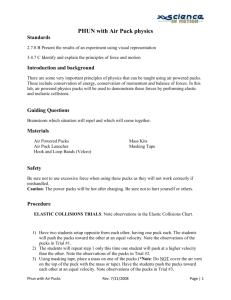Natural science: Active learning in dynamic physical microworlds
advertisement
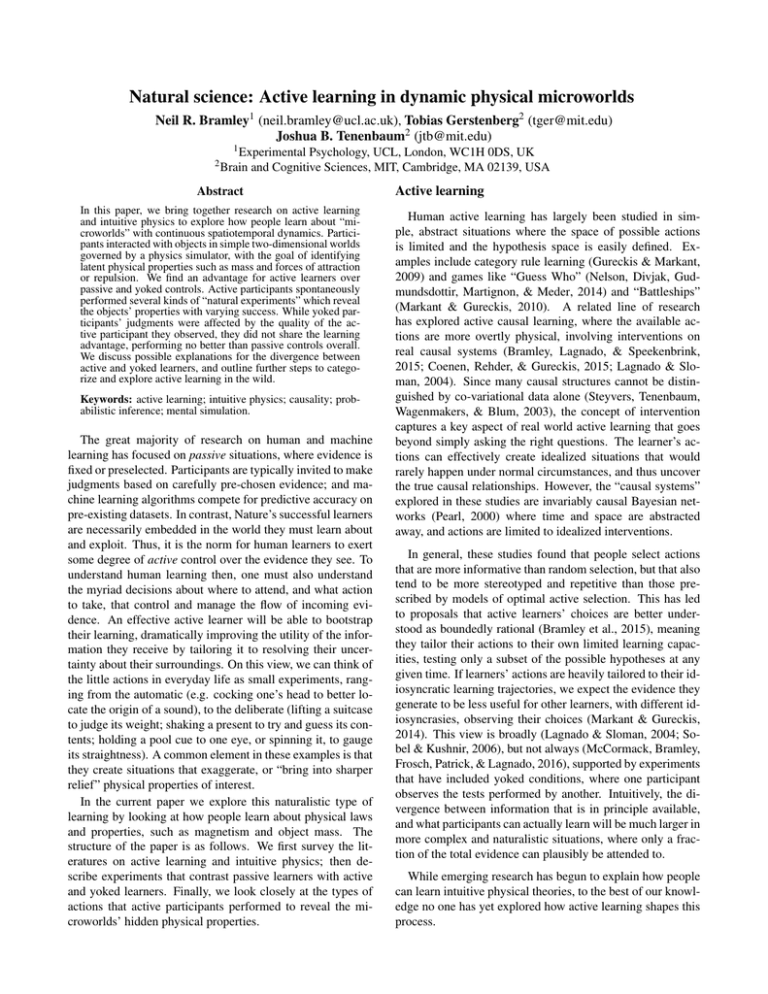
Natural science: Active learning in dynamic physical microworlds Neil R. Bramley1 (neil.bramley@ucl.ac.uk), Tobias Gerstenberg2 (tger@mit.edu) Joshua B. Tenenbaum2 (jtb@mit.edu) 1 Experimental 2 Brain Psychology, UCL, London, WC1H 0DS, UK and Cognitive Sciences, MIT, Cambridge, MA 02139, USA Abstract In this paper, we bring together research on active learning and intuitive physics to explore how people learn about “microworlds” with continuous spatiotemporal dynamics. Participants interacted with objects in simple two-dimensional worlds governed by a physics simulator, with the goal of identifying latent physical properties such as mass and forces of attraction or repulsion. We find an advantage for active learners over passive and yoked controls. Active participants spontaneously performed several kinds of “natural experiments” which reveal the objects’ properties with varying success. While yoked participants’ judgments were affected by the quality of the active participant they observed, they did not share the learning advantage, performing no better than passive controls overall. We discuss possible explanations for the divergence between active and yoked learners, and outline further steps to categorize and explore active learning in the wild. Keywords: active learning; intuitive physics; causality; probabilistic inference; mental simulation. The great majority of research on human and machine learning has focused on passive situations, where evidence is fixed or preselected. Participants are typically invited to make judgments based on carefully pre-chosen evidence; and machine learning algorithms compete for predictive accuracy on pre-existing datasets. In contrast, Nature’s successful learners are necessarily embedded in the world they must learn about and exploit. Thus, it is the norm for human learners to exert some degree of active control over the evidence they see. To understand human learning then, one must also understand the myriad decisions about where to attend, and what action to take, that control and manage the flow of incoming evidence. An effective active learner will be able to bootstrap their learning, dramatically improving the utility of the information they receive by tailoring it to resolving their uncertainty about their surroundings. On this view, we can think of the little actions in everyday life as small experiments, ranging from the automatic (e.g. cocking one’s head to better locate the origin of a sound), to the deliberate (lifting a suitcase to judge its weight; shaking a present to try and guess its contents; holding a pool cue to one eye, or spinning it, to gauge its straightness). A common element in these examples is that they create situations that exaggerate, or “bring into sharper relief” physical properties of interest. In the current paper we explore this naturalistic type of learning by looking at how people learn about physical laws and properties, such as magnetism and object mass. The structure of the paper is as follows. We first survey the literatures on active learning and intuitive physics; then describe experiments that contrast passive learners with active and yoked learners. Finally, we look closely at the types of actions that active participants performed to reveal the microworlds’ hidden physical properties. Active learning Human active learning has largely been studied in simple, abstract situations where the space of possible actions is limited and the hypothesis space is easily defined. Examples include category rule learning (Gureckis & Markant, 2009) and games like “Guess Who” (Nelson, Divjak, Gudmundsdottir, Martignon, & Meder, 2014) and “Battleships” (Markant & Gureckis, 2010). A related line of research has explored active causal learning, where the available actions are more overtly physical, involving interventions on real causal systems (Bramley, Lagnado, & Speekenbrink, 2015; Coenen, Rehder, & Gureckis, 2015; Lagnado & Sloman, 2004). Since many causal structures cannot be distinguished by co-variational data alone (Steyvers, Tenenbaum, Wagenmakers, & Blum, 2003), the concept of intervention captures a key aspect of real world active learning that goes beyond simply asking the right questions. The learner’s actions can effectively create idealized situations that would rarely happen under normal circumstances, and thus uncover the true causal relationships. However, the “causal systems” explored in these studies are invariably causal Bayesian networks (Pearl, 2000) where time and space are abstracted away, and actions are limited to idealized interventions. In general, these studies found that people select actions that are more informative than random selection, but that also tend to be more stereotyped and repetitive than those prescribed by models of optimal active selection. This has led to proposals that active learners’ choices are better understood as boundedly rational (Bramley et al., 2015), meaning they tailor their actions to their own limited learning capacities, testing only a subset of the possible hypotheses at any given time. If learners’ actions are heavily tailored to their idiosyncratic learning trajectories, we expect the evidence they generate to be less useful for other learners, with different idiosyncrasies, observing their choices (Markant & Gureckis, 2014). This view is broadly (Lagnado & Sloman, 2004; Sobel & Kushnir, 2006), but not always (McCormack, Bramley, Frosch, Patrick, & Lagnado, 2016), supported by experiments that have included yoked conditions, where one participant observes the tests performed by another. Intuitively, the divergence between information that is in principle available, and what participants can actually learn will be much larger in more complex and naturalistic situations, where only a fraction of the total evidence can plausibly be attended to. While emerging research has begun to explain how people can learn intuitive physical theories, to the best of our knowledge no one has yet explored how active learning shapes this process. Intuitive physics In recent years, research into people’s intuitive understanding of physics has experienced a revival. This is partly due to the ease with which we can design physically realistic displays thanks to available software packages with physics engines. While early research into intuitive physics had focused on documenting how people’s understanding of some aspects of physics, such as ballistic and curvilinear motion, is sometimes systematically biased (e.g. McCloskey, Caramazza, & Green, 1980), more recent research has demonstrated how some of these biases may be explained if we assume that 1) our physical understanding is approximately Newtonian, and 2) we are often fundamentally uncertain about some important aspects of the physical scene (e.g., the masses of the objects involved in a collision, Sanborn, Mansinghka, & Griffiths, 2013). Battaglia, Hamrick, and Tenenbaum (2013) have argued that people’s understanding of physics is best understood in analogy to a physics engine used to produce physically realistic scenes. Accordingly, people have a physics simulator in their mind that they can use to approximately predict what will happen in the future (Smith & Vul, 2013), reason about what happened in the past (Smith & Vul, 2014), or simulate what would have happened if some aspect of the situation had been different (Gerstenberg, Goodman, Lagnado, & Tenenbaum, 2015). The results of these experiments are consistent with the view that people have a rich intuitive theory of physics that supports approximately accurate mental simulations of key aspects of physical scenes. However, these experiments do not address the question of how we get there – how do people acquire their intuitive physical theories? Intuitive theories can be expressed as probabilistic programs (Gerstenberg & Tenenbaum, to appear). Program induction is a thorny problem, but one where human-like performance has been demonstrated (Lake, Salakhutdinov, & Tenenbaum, 2015) by sophisticated Bayesian machinery embodying principles of causality and compositionality. Ullman, Stuhlmüller, Goodman, and Tenenbaum (2014) explored human intuitive physics learning, by studying how people learn about different latent physical properties of 2D “microworlds” similar to the ones shown in Figure 1. The worlds were bounded by solid walls and contained a number of colored pucks with differing weights, surfaces with differing levels of friction, as well as local (magnet-like) forces between pucks and a global (gravity-like) force pulling all the pucks in a particular direction. In each clip, the pucks bounced around, attracting and repelling each other, being slowed down by the friction, and being pulled by the global force. Participants answered a series of questions about each world’s properties. Participants were able to detect different levels of mass and friction on average but individual judgments were noisy. They identified the correct global force around 70% of the time and were much better at detecting local attraction (82%) than repulsion (53%). Ullman et al. found that divergence was matched by an asymmetry in B A A A B B B (a) “Punch” condition in pilot study. (b) “Grab” condition in experiment. Figure 1: Schematic displays of two “microworlds”. the evidence: pucks that repelled one another would rarely spend long enough close together to exhibit strong repulsion, while attracting pucks would rapidly approach one another and stick together offering stronger evidence of the latent force. Ullman et al. modeled participants’ judgments by assuming a mixture of an Ideal Observer model (IOM) and a Simulation Based Approximation model (SBAM). The IOM compares the observed objects’ trajectories to simulations of expected trajectories under the different possible worlds. The model assumes that people have uncertainty about the pucks’ exact locations and velocities. The SBAM compared statistics about each clip such as the pucks’ average positions, velocities and pairwise distances, to the summary statistics of repeated simulations under the different possible worlds. For instance, objects in worlds with a global force towards south tend to be closer to the southern wall of the world. A mixture model that combined both IOM and SBAM had a .81 correlation with participants’ judgments. Individually, the SBAM did a better job than the IOM on predicting all but global force judgments. In the current work we build on these results, exploring how people interact with physical microworlds and how this impacts on their learning of the different physical properties. Pilot study: From Passive to Active For our pilot study we adapted the setup from Ullman et al.. However, rather than showing participants prechosen replays, we generated the simulations on the fly to allow for active conditions in which participants could exert control over the scene and alter how it played out. There are many ways in which participants could be allowed to interact with the worlds. We chose two setups that differed in the extent to which participants had fine-grained control over the scene. In the “active punch” condition, participants controlled a fist that allowed them to roughly trap and knock the other objects around, mimicking the clumsy actions of a baby yet to develop fine motor skills. In the “active grab” condition, we allowed learners to use the mouse to grab the pucks with the mouse and drag them around, staging more precisely orchestrated interactions. We were interested in whether active participants would be able to use these forms of control to better identify the forces than the passive participants; or conversely if the costs of controlling while learning would lead to worse performance. 1. Passive Participants observed the microworlds unfold without being able to interact. 2. “Active punch” In addition to the four pucks, this condition featured a “fist” (see Figure 1a). The fist was the same size as the pucks but was heavier (10 kg) and less elastic (50%). The fist was initially located in the middle of the screen but strongly attracted to the location of the participant’s mouse. 3. “Active grab” In this condition, participants could leftclick on any of the pucks and hold the mouse clicked to drag them around. Grabbed pucks retained their properties (i.e. mass and local forces) but were now strongly attracted to the position of the mouse. Worlds Each participant either passively observed or actively interacted with 18 microworlds. These were made up of all combinations of the six possible within-color local force patterns [None-None, Attract-Attract, Repel-Repel, None-Attract, None-Repel, Attract-Repel] and the three possible between-color local forces [None, Attract, Repel]. Half of the microworlds also had a global force in one of the four compass directions. Object colors and direction of the global force were counterbalanced. Procedure Participants were instructed about the setup of the microworlds, what judgments they had to make, and – if they 1 Local forces scaled with the inverse squared distance between the objects in line with Newton’s universal law of gravitation. Thus the current local force L exerted on object o1 by object o2 (and the reverse) was given by d32 . Judgment 100 Attract None Repel Dunno ● 75 ● ● ● 50 25 passive active punch Ground truth Participants Sixty participants were recruited through Amazon Mechanical Turk (34 male, age 33.5 ± 9.7). They were paid at a rate of $6 per hour. Materials The experiment was programmed in javascript using a port of the Box2D physics game engine. The microworlds were displayed in a 600 by 400 pixel frame, with 1 m in the world corresponding to 100 pixels on the screen. Each world was bounded by solid walls with high elasticity (90% of energy retained per collision) – and contained four pucks (2 yellow, 2 red, all with radius .25 meters, mass 1 kg and elasticity 75%). Each world either had a global force of 1 m/s2 in one of the four compass directions, or no global force. Each world also had up to three distinct local forces, one between the yellow pucks, one between the red pucks, and one between pucks of differing colors. Each of these could either be attractive (3 m/s2 ), repulsive (−3 m/s2 ), or no force.1 The pucks’ initial positions were random but nonoverlapping, with initial velocities in the x and y direction drawn from Unif(−10, 10) m/s. Whenever all pucks’ velocities fell below .15 m/s, the simulation froze and the window went black for 500 ms before the positions and velocities of the pucks were redrawn. Each world was simulated for 30 seconds at 60 frames per second. Conditions Participants were randomly assigned to one of three learning conditions, 21 passive, 20 active punch, 19 active grab (see Figure 1): % accurate Methods Attract 86% 4% None 40% 28% 25% 7% Repel 11% 16% 66% 7% 7% 3% active grab (a) Boxplots of accuracy by condition. (b) Confusion matrix for local force judgments. Figure 2: Pilot study performance plots. were in an active condition – how they could interact with the pucks. Participants first saw two practice trials, and then the 18 test trials in randomized order. On each trial, participants answered 4 questions: One question about the direction of the global force (response options: “North”, “East”,“South”,“West”,“None” and “Don’t know”), and one question each about the local forces between pucks of the same color (red and yellow), and pucks of different color (response options: “Attract”, “None”,“Repel” and “Don’t know”). Participants took on average 22.4 ± 9.3 minutes to complete the experiment.2 Results Participants in the passive, active punch, and active grab condition answered on average 64%, 62% and 61% of the questions correctly. Chance performance was approximately 30%.3 Thus, judgments were well above chance in all three conditions. However, there was no main effect of condition on performance F(2, 57) = .38, p = .67. As Figure 2a shows, both the highest and the lowest performing participants were in the active punch condition, suggesting that an active learning advantage for this scenario was at least possible although not generally achieved. On the global force question people were less good at identifying when there was no force, with accuracy of only 42% when the right answer was “none” compared to an average of 85% when the right answer was one of the compass directions. There was an interaction between global force type and condition LR = 22.5, p = 0.013, with only 40% in the active punch and 30% in active grab condition identifying when there was no global force compared to 57% in the passive condition. For the local force questions, accuracy differed considerably depending on the ground truth. Participants in the active grab condition were better than passive and active punch participants at identifying repel forces with an overall accuracy of 77% compared to 68% and 70%. Due to the simulation restarting whenever all the pucks fell below a certain velocity (2.0 ± .8 times per trial on average), participants in the passive condition actually experienced significantly more puck motion than the active participants. We 2 A complete specification settings of the Box2D physics simulator and demos of both experiments are available at ucl.ac.uk/lagnado-lab/el/apl. 3 Any “don’t know” responses were treated as judgments spread evenly across the remaining 3 or 5 options. Random responding would be correct with probability ≈ 41 × 15 + 34 × 13 = .3 can see this in terms of the total distance traveled by the four colored pucks over the trials of 168 ± 47, 98 ± 55, 85 ± 73 meters for passive, active punch and active grab conditions. For the participants in the active grab condition, more time spent manipulating the pucks was positively related to performance F(1, 17) = 7.2, p = .015. Interim Discussion While participants’ overall accuracy was not affected by learning condition, participants’ performance in the active grab condition was more variable and depended on the extent to which learners used their ability to grab and move the pucks around. The lower performance of active participants on the global force question might indicate that attending to a controlled object and its immediate surroundings led participants to neglect global properties of the scene (i.e. that the pucks would all tend to congregate on one side of the world). The trend toward better performance in identifying repel forces by the active participants might reflect the fact that active participants were able to force the repellent pucks closer together and thus gain more experience of these forces in action. In contrast, passive participants would tend to predominantly experience evidence of attraction through seeing attracting pucks frequently converging and “sticking together”. There are several possible explanations for the lack of a difference in accuracy between conditions in the pilot. One is that the restarts of the simulation in the passive condition meant that passive participants would naturally experience more balanced clips with more time during which pucks move and interact at reasonable velocities. While active participants had to put in work to create these experiences (evidenced by the higher variance but lower average puck motion), they were seen “for free” in the passive condition. Another possibility is that the setup of the pilot was not well suited for active exploration. 30 seconds may have been too little time to allow for sequential, controlled testing, especially of four distinct physical properties. Furthermore, the probed properties may have been ones that were just as easy to observe passively as via active testing. A third possibility is that the learning aspect of the task was actually too easy. End-of-task feedback suggested that errors were often more due to failure to attend to all the required properties within the 30 second window; failure to hold the answers in working memory until the end of each trial; or failure to segment the different worlds in memory by mixing up properties experienced in the current versus previously experienced worlds. Main Experiment For our main task we used the same setup as in the pilot but made a number of changes to address the issues identified above. Firstly, we improved the match between passive and active conditions by tweaking the settings of the microworlds so that objects rarely came to rest within the the length of a trial. We increased the elasticity of the pucks from 75% to 98%, leading to restarts occurring only in exceptional situations. Additionally, we replaced the active punch condition Table 1: Experiment design. Note: A = attract, N = none, R = repel; masses are in kg. World Target force Target 1 mass Target 2 mass 1 A 1 1 2 A 2 1 3 A 1 2 4 N 1 1 5 N 2 1 6 N 1 2 7 R 1 1 8 R 2 1 9 R 1 2 with a yoked condition (cf. Lagnado & Sloman, 2004), in which participants were matched with one of the active grab participants and observed their mouse movements and controlling actions. To increase the scope for active hypothesis testing, we increased the length of the trials and asked more difficult test questions (see below). Because active testing is particularly valuable when competing causal explanations cannot be resolved by observational evidence only, we generated confounded evidence by including two distractor pucks along with two target pucks and drew local forces randomly out of attract/none/repel for all pairs of target and distractor objects. This means that it was more important to isolate the target pucks from the distractor pucks to get clear information about the target pairwise force. Instead of including a global force, which was easily identified by passive learners, we varied the relative mass of the two target objects, a property which is more difficult to infer without experiencing curated comparisons and interactions between them. To reduce memory load we asked two rather than four questions per trial. To ensure that participants were motivated to answer the questions as well as they could, we paid a bonus for each correct response. Finally, to get a more fine-grained measure of participants’ judgments, we added confidence sliders for each test question and removed the “don’t know” option. We hypothesized that in these worlds active participants would outperform passive participants, and that yoked participants would inherit some, but not all of this advantage. Methods Participants Sixty-four participants were recruited from Amazon Mechanical Turk (39 male, age 33.6 ± 10.2). Participants were paid at a rate of $6 per hour, plus performancerelated bonuses ($0.61 ± .17) . Design The first 44 participants were randomly assigned to either the passive (24) or the active (20) learning condition, and the final 20 were yoked 1-to-1 with the 20 active participants. Each participant watched or interacted with 9 microworlds, consisting of all combinations of target force in attract, repel and none and target masses in [1, 1]kg, [1, 2]kg and [2, 1]kg (see Table 1). The five other pairwise forces were drawn uniformly from the three possibilities for each participant on each trial. There were no global forces. Materials and Procedure We used the same basic set up as in the pilot, but ran the simulations for 45 rather than 30 seconds and increased the elasticity of the pucks from .75 to .98. Rather than two yellow and two red pucks, we drew four random colors for each new world. The two target pucks were labeled with new letters on each trial (e.g. “A” and “B” A A A A A B A B B (a) Deconfounding B B B B B B (b) Encroaching (c) Launching (d) Knocking B (e) Throwing B B A A (f) Shaking Figure 3: Examples of different interventions participants performed in the active grab condition. on trial one, “C” and “D” on trial two, cf. Figure 1b). The distractor pucks were all 1 kg as before but now one of the target pucks could weigh 2 kg. For yoked participants, the cursor of the participant to whom they were yoked (hereafter the yoker) was shown with a large “+” symbol whenever it was within the world, and any objects grabbed by the yoker were indicated as in the active condition with a thick black border. Participants first completed instructions relevant to their condition, answered comprehension check questions, and then faced two practice trials followed by the nine test trials. Practice trials were always worlds 1 and 5. The randomly drawn distractor forces, puck colors and labels differed between the practice and test instances. The two test questions appeared below the world when the time was up. Question order was counterbalanced between participants. At the end of the experiment, participants received feedback about how many of the test questions they got right, and were paid a 5c bonus for each correct answer. The experiment took 19.0 ± 7.3 minutes on average. Results Overall accuracy Participants answered 53%, 66% and 54% of questions correctly in the passive, active and yoked conditions respectively (see Figure 4). Average performance differed significantly by condition F(2, 61) = 3.8, η2 = .12, p = .03. Post-hoc tests revealed that active participants answered significantly more questions correctly than passive participants t(42) = 2.5, p = 0.02, and their yoked counterparts t(19) = 2.9, p = 0.02, with negligible difference between passive and yoked participants t(42) = .2, p = 0.83. Only 4 yoked participants outperformed their active counterparts, with a further 3 answering the same number of questions correctly. Yoked participants’ performance was correlated with their active counterparts’ r = .49, p = .03. 100 ● Masses vs. relationships Across conditions, participants were worse at inferring masses than forces t(63) = −4.8, p < .0001 and reported lower confidence in mass judgments 66 ± 25% compared to force judgments 74 ± 25% t(575) = 6.4, p < .001. Again, participants were less accurate in correctly identifying that there was no force between the target pucks (56%) than repulsion (70%) or attraction (78%). This did interact with condition LR = 22, p < .0001. Dummy contrasts with no force and passive as controls revealed active t(634) = 4.2, p < .0001 and yoked participants t(506) = 2.4, p < .0001 were significantly better at identifying repel than passive participants. There was no significant relationship between accuracy on the local force question and the number of distractor forces. Confidence judgments differed by condition LR = 10, p = .008, with active participants significantly more confident on average than passive t(61) = 2.7p = .008 or yoked participants t(61) = 2.9, p = .005. Confidence was positively correlated with accuracy β = .008, LR = 30, p < .0001 but did not interact with condition LR = 4, p = .39. Natural experiments Active participants experienced slightly fewer between-puck collisions than passive participants, 59 ± 14 compared to 65 ± 9,t(42) = 2.0, p = 0.056. However they experienced significantly more collisions between the two target pucks 15.0 ± 8.1, compared to 9.8 ± 4.4,t(42) = 2.7, p = 0.01. 13.2 ± 7.8 of collisions in the active condition took place while one of the two target objects was being controlled by the participant. Time spent controlling objects was positively related to final performance for active and yoked participants F(1, 38) = 4.8, η2 = 11, p = 0.04. Therefore, a key question is what kinds of experiments active participants used to find answers to the test questions. Space constraints prohibit a full analysis in the present paper, but we want to share some of the strategies that participants discovered (see Figure 3 and ucl.ac.uk/lagnado-lab/aplc): ● % accurate ●● ● ● ● ● ● ● ● ● ● 75 ● ● ●● ● ● ● ● ●● ● ● ● ● ●● ● ● ● ● ● ● ● ● ● 50 ● ● ● ● ● ● ● ● ● ● ● ● ● ● ● ● ● ● ● ●● ● ● ● ● ●● ● 25 ● passive active yoked Figure 4: Performance by condition in the main task. Note: Large dots indicate condition means. Small dots indicating individual participants in are jittered for visibility. Dotted lines connect active participants with matched yoked participants. (a) Deconfounding Even though participants mainly manipulated the target pucks, they also sometimes manipulated the distractor pucks. Many of these manipulations involved moving the distractor pucks out of the way and leaving them at rest in a far corner. (b) Encroaching Participants grabbed one target puck and brought it toward the other target puck. This simple strategy allowed participants to infer whether and how the two pucks affected one another. In some cases, participants towed one attracting puck with the other, or pushed a repulsive puck around with the other providing a strong and extended demonstration of the force between the pucks. (c) Launching Participants grabbed one of the target pucks and flicked it against the other target puck. This intervention helps to figure out whether one of the targets is heavier than the other. (d) Knocking Similar to launching, participants grabbed one of the target pucks and knocked it against the other (without letting it go). This intervention also reveals information about the mass of each object. (e) Throwing Participants grabbed a target puck and then threw it, explicitly avoiding collision with any of the other pucks. By exerting an identical force when throwing each target ball, the results of the intervention help to figure out the mass of each object. (f) Shaking Some participants discovered an effective strategy for comparing the mass of the two target objects. By rapidly shaking each in turn (moving the mouse from side to side) it was possible to see that the heavier object reacted more slugglishly. Its greater momentum takes longer to be counteracted by its attraction to the mouse location. In line with encroaching (Figure 3b), we see evidence that participants in the active condition identified the local forces by bringing the two target pucks close to each other. The lower the average distance between two target objects for an active participant, the better they did on the force question β = −.3, F(1, 18) = 8.0, η2 = .3, p = .001 but this had no relationship with accuracy on the mass question p = .87. Conversely, in line with the shaking strategy (Figure 3f), participants who moved the controlled object around faster did better on the mass question β = 25, F(1, 18) = 15, η2 = .45, p < 0.001, but controlled object speed had no relationship with accuracy on the force question p = .67. Yoked participants did not inherit these differences, with no significant relationships between performance on either question and average distance between targets or controlled-object speed. Discussion We found a clear benefit for active over passive learning in this experiment. In particular, active participants gathered more evidence about repulsive forces by bringing target objects closer together. The quality of the control exerted by the active participants was an important determinant of the quality of the final evidence available to the yoked participants. However, the substantial drop-off from active to yoked accuracy was consistent with the idea that first-hand knowledge of what was being tested (e.g. relationship or mass), when and how, was likely to be crucial for learning successfully. Since there are too many objects and properties in play to track at once, it helps to align the evidence with the hypotheses currently considered. Another factor might have been that active participants were able to look ahead at the crucial locations in the scenes where diagnostic interactions were expected to occur. Yoked participants lacked the ability to foresee what will happen. Finally, active participants have an additional advantage over yoked participants by receiving direct motor feedback about their interventions. They experience how quickly they moved the mouse or their finger on the trackpad and thus have an immediate sense for how much force they exerted. Encroaching and shaking permitted simple indirect measures, and accordingly, we found shakers doing better on mass questions and encroachers doing better on relationship questions. The other experiments’ timeline signatures were more subtle, so will be further explored in future work. Interestingly, certain other “experiments” were less effective. For example in this clip (ucl.ac.uk/lagnado-lab/el/apdc1), the participant puts one target in a corner and approaches with another, in doing so they fail to reveal that the objects repel one another. In this clip (ucl.ac.uk/lagnado-lab/el/apdc2) the participant reveals a mistaken assumption of a downward global force (i.e. gravity) by repeatedly trying to drop objects from the top of the frame, presumably to reveal their mass. While the current study provides a valuable first step, there is much more to explore here. In future work we plan to explore the possibility that learners have a generative grammar for constructing these natural experiments, and unpacking yoking differences by looking at yoked participants’ ability to infer the learning intentions and action plans of active learners. References Battaglia, P. W., Hamrick, J. B., & Tenenbaum, J. B. (2013). Simulation as an engine of physical scene understanding. Proceedings of the National Academy of Sciences, 110(45), 18327–18332. Bramley, N. R., Lagnado, D. A., & Speekenbrink, M. (2015). Forgetful conservative scholars - how people learn causal structure through interventions. Journal of Experimental Psychology: Learning, Memory and Cognition, 41(3), 708-731. Coenen, A., Rehder, B., & Gureckis, T. M. (2015). Strategies to intervene on causal systems are adaptively selected. Cognitive Psychology, 79, 102–133. Gerstenberg, T., Goodman, N. D., Lagnado, D. A., & Tenenbaum, J. B. (2015). How, whether, why: Causal judgments as counterfactual contrasts. In Proceedings of the 37th Annual Conference of the Cognitive Science Society (pp. 782–787). Gerstenberg, T., & Tenenbaum, J. B. (to appear). Intuitive theories. In M. Waldman (Ed.), Oxford handbook of causal reasoning. Oxford University Press. Gureckis, T. M., & Markant, D. (2009). Active learning strategies in a spatial concept learning game. In Proceedings of the 31st annual conference of the cognitive science society (pp. 3145–3150). Lagnado, D. A., & Sloman, S. (2004). The advantage of timely intervention. Journal of Experimental Psychology: Learning, Memory & Cognition, 30, 856–876. Lake, B. M., Salakhutdinov, R., & Tenenbaum, J. B. (2015). Human-level concept learning through probabilistic program induction. Science, 350(6266), 1332–1338. Markant, D. B., & Gureckis, T. M. (2010). Category learning through active sampling. Proceedings of the of the 32nd Annual Meeting of the Cognitive Science Society, 248–253. Markant, D. B., & Gureckis, T. M. (2014). Is it better to select or to receive? learning via active and passive hypothesis testing. Journal of Experimental Psychology: General, 143(1), 94. McCloskey, M., Caramazza, A., & Green, B. (1980). Curvilinear motion in the absence of external forces: Naı̈ve beliefs about the motion of objects. Science, 210(4474), 1138–1141. McCormack, T., Bramley, N. R., Frosch, C., Patrick, F., & Lagnado, D. A. (2016). Children’s use of interventions to learn causal structure. Journal of Experimental Child Psychology, 141, 1-22. Nelson, J. D., Divjak, B., Gudmundsdottir, G., Martignon, L. F., & Meder, B. (2014). Children?s sequential information search is sensitive to environmental probabilities. Cognition, 130(1), 74–80. Oaksford, M., & Chater, N. (1994). A rational analysis ofthe selection task as optimal data selection. Psychological Review, 101(4), 608–631. Pearl, J. (2000). Causality. New York: Cambridge University Press (2nd edition). Sanborn, A. N., Mansinghka, V. K., & Griffiths, T. L. (2013). Reconciling intuitive physics and newtonian mechanics for colliding objects. Psychological Review, 120(2), 411. Smith, K. A., & Vul, E. (2013). Sources of uncertainty in intuitive physics. Topics in Cognitive Science, 5(1), 185–199. Smith, K. A., & Vul, E. (2014). Looking forwards and backwards: Similarities and differences in prediction and retrodiction. In Proceedings of the 36th Annual Conference of the Cognitive Science Society (pp. 1467–1472). Sobel, D. M., & Kushnir, T. (2006). The importance of decision making in causal learning from interventions. Memory & Cognition, 34(2), 411–419. Steyvers, M., Tenenbaum, J. B., Wagenmakers, E., & Blum, B. (2003). Inferring causal networks from observations and interventions. Cognitive Science, 27, 453-489. Ullman, T., Stuhlmüller, A., Goodman, N., & Tenenbaum, J. (2014). Learning physics from dynamical scenes. In Proceedings of the thirty-sixth annual conference of the cognitive science society.
